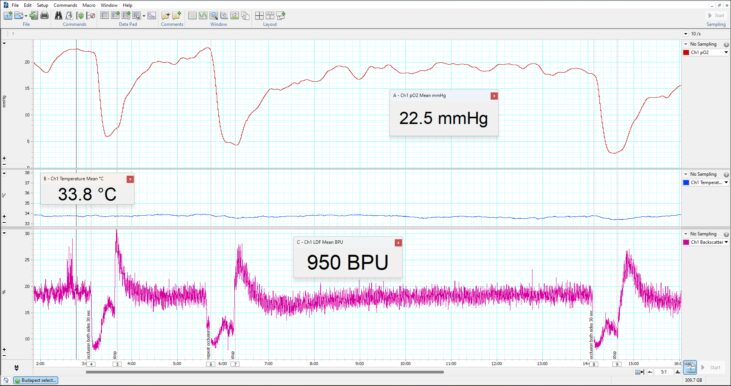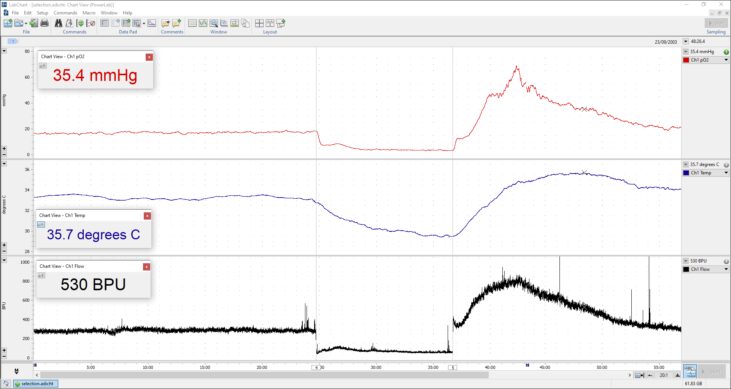One of the most powerful and unique features offered by our tissue vitality monitors is the ability to measure tissue oxygen, laser-Doppler blood flow and temperature simultaneously from the same tissue micro-region. This is achieved by combining counterpart oxygen and blood flow monitors into a ‘stack’ arrangement and using our unique, combined, multi-parameter sensors.
In its most extreme implementation, consisting of 4-channel OxyLite™ Pro and 4-channel OxyFlo™ Pro devices in a stack arrangement this allows the collection of multi-parameter physiological data from up to four independent tissue sites at one time, for unsurpassed data collection and productivity potential.
Please refer to the individual product pages for in-depth key features and benefits.
Applications in which our OxyLite™ oxygen monitors and our OxyFlo™ blood flow monitors have been employed jointly for the simultaneous monitoring of tissue oxygen, blood perfusion and temperature include:
Intended use statement:
OxyLite™ (Pro) and OxyFlo™ (Pro) are intended for laboratory, industrial and research use only.
by Justin Croft, 24 November 2022
by Justin Croft, March 2020

Florey Institute of Neuroscience and Mental Health, Melbourne, Australia
Investigating the pathophysiology of brain and kidney injury caused by sepsis, heart surgery and heart failure

The Florey Institute, University of Melbourne, Australia
Investigating the causes of acute kidney injury in sepsis and following cardiopulmonary bypass


A single, combined oxygen, blood flow and temperature sensor (product code NX-BF/OFT/O) was used to invasively measure the effect of transient global cerebral ischaemia induced by common carotid artery occlusion. The upper trace shows pO2 in units of mmHg, the middle trace shows temperature in units of degrees C, while the lower trace shows continuous blood flow in arbitrary 'blood perfusion units' (BPU). A period of baseline is followed by a window of occlusion, then release of the occlusion.
Do I need separate instruments to measure all supported parameters?
Yes, our instruments are provided as modular units for enhanced user flexibility and therefore both an oxygen monitor and a blood flow monitor are required to drive our combined, multi-parameter sensors. Our multi-parameter, combined sensors feature two connectors, one for each monitor type. Normal configuration involves ‘stacking’ together either single-channel monitors or multi-channel monitors. Potentially a mix of single and multi-channel monitors can be used.
Are your multi-parameter sensors MRI-compatible?
Two of our bare-fibre sensor types (NX-MRI/BF/O/E and NX-MRI/BF/OF/E) are offered at an 8 m length for remote sensing applications, including MRI. The latter supports combined oxygen and blood flow monitoring and provides full MRI compatibility. Integrated temperature is not supported since this constitutes a metallic component.
Can I use more than one combined sensor at the same time?
Yes. Using a stack of dual-channel (Pro) or four-channel (Pro XL) monitors, up to two or up to four combined sensors can be driven simultaneously, potentially providing multi-parameter physiological data from up to four different tissue sites at the same time. This may be useful when comparing pathological versus control tissue sites or in mitigating for natural tissue variability by allowing multi-site data averaging.
Do your monitors possess regulatory approval for clinical use?
At this time our instruments and sensors do NOT possess CE or FDA regulatory approvals for use on human subjects.
Do you offer on-site demonstrations of your instruments?
Yes, depending on geographical location we will try to arrange for an on-site demonstration of our products by an experienced product specialist. Ideally this will involve a full simulation of your application in order to maximise the benefit of the demonstration. On-site demonstrations are usually free of charge and can typically be arranged at 2 – 8 weeks notice. Alternatively we can also arrange for a limited free trial of our monitors and sensors.
“In our studies on the response to gas inhalation in abdominal organs, OxyLite and OxyFlo allowed us to monitor tissue pO2 and perfusion response simultaneously in the liver and kidney. No other minimally invasive system could capture dynamic changes with such fine temporal resolution, and no other system could provide concurrent pO2 and perfusion measurement in multiple tissue regions. Oxford Optronix enabled us to understand the physiological phenomena underlying our magnetic resonance imaging measurements. It is truly a powerful, must-have technology.”
Dr Hai-Ling Margaret Cheng, University of Toronto, Hospital for Sick Children, Toronto, Canada
“I found Oxford Optronix´s group of experts to be knowledgeable, friendly and supportive with regular feedback capable to overcome any challenge. The [OxyLite / OxyFlo] system offers a broad range of in vivo applications that provided us the data we require.”
Prof. Martin Matejovic, Charles University and Teaching Hospital, Plzen, Czech Republic
“We collaborate with Oxford Optronix for several years now. Oxford Optronix provided us with an excellent technical support during our efforts in the field of multi-parametric neuro-monitoring. We are impressed not only by their products but also by their commitment to develop cutting edge products for experimental and clinical neuroscience.”
Dr Beat Alessandri, University Medical Center of the Johannes Gutenberg-University, Germany
“.. great products with tremendous support. The knowledgeable members of your team are always extremely helpful. The OxyLite and OxyFlo units have been a great asset to our research”
Dr Gregory Hare, University of Toronto, St. Michael’s Hospital, Toronto, Canada
“In [our] experiments we measure: continuous, relative cortical CBF with your laser Doppler implanted probes, intermittent, but absolute CBF with fluorescent-labelled microspheres, cortical tissue pO2 with your implanted [sensors], cerebral arterio-venous difference and thus the cerebral metabolic rate for O2 by having a sagittal sinus catheter, and electroencephalogram (EEG) for neuronal activity and “sleep state”. Technologically, the experiments are quite a Tour de Force. I thank you, because without the technological expertise Oxford Optronix provides, we could not perform these studies.”
Prof Lawrence Longo, Loma Linda University, CA, United States
“We use OxyFlo Pro and OxyLite Pro devices in our piglet experiments that focus on validating the non-invasive modalities of quantifying cerebral pressure autoregulation and neurovascular coupling. This is an ongoing project to understand elucidate the mechanisms of brain injury in critically ill infants. We are extremely satisfied with the Oxford Optronix devices. Their customer support service is phenomenal.”
Dr Rathinaswamy Govindan, Children’s National Medical Center, Washington DC, United States
“We are currently using … the OxyLab LDF and the … OxyLab pO2 … in animal experiments to take recordings in brain tissue. Both of these monitoring systems have proven of great value in studies on focal brain ischemia and reperfusion, in which we have addressed the role of collateral blood flow on tissue perfusion, oxygen supply, and the development of ischemic brain damage. A publication of these data is presently in preparation.”
Prof Lothar Schilling, Universitätsklinikum, Mannheim, Germany
For specifications please follow the links below:
OxyLite oxygen monitor specifications
OxyFlo blood flow monitor specifications
Research areas in which our OxyLite™ and OxyFlo™ monitors have been combined to provide simultaneous measurements of tissue oxygen, blood flow and temperature are numerous.
Click below to browse our exhaustive PDF of journal citations.
Note: this list contains a mix of articles citing the use of OxyLite™ and OxyFlo™ monitors in isolation, as well as articles citing their simultaneous use for multi-parameter monitoring.
Chen SM, Phuagkhaopong S, Fang C, Wu JCC, Huang YH, Vivithanaporn P, Lin HH and Tsai CY (2019). Dose-Dependent Acute Circulatory Fates Elicited by Cadmium Are Mediated by Differential Engagements of Cardiovascular Regulatory Mechanisms in Brain. Front Physiol. 10, 772
O'Neill J, Jasionek G, Drummond SE, Brett O, Lucking EF, Abdulla MA and O'Halloran KD (2019). Renal cortical oxygen tension is decreased following exposure to long-term but not short-term intermittent hypoxia in the rat. Am J Physiol Renal Physiol 316(4):F635-F645
Lankadeva YR, Evans RG, Kosaka J, Booth LC, Iguchi N, Bellomo R and May CN (2018). Alterations in regional kidney oxygenation during expansion of extracellular fluid volume in conscious healthy sheep. Am J Physiol Regul Integr Comp Physiol 315(6), R1242-R1250
Harris SS, Boorman LW, Kennerley AJ, Sharp PS, Martin C, Redgrave P, Schwartz TH and Berwick J (2018). Seizure epicenter depth and translaminar field potential synchrony underlie complex variations in tissue oxygenation during ictal initiation. Neuroimage 171, 165-175
Wang KC, Tang SC, Lee JE, Tsai JC, Lai DM, Lin WC, Lin CP, Tu YK and Hsieh ST (2018). Impaired microcirculation after subarachnoid hemorrhage in an in vivo animal model. Sci Rep 8(1):13315
Streijger F, So K, Manouchehri N, Gheorghe A, Okon EB, Chan RM, Ng B, Shortt K, Sekhon MS, Griesdale DE and Kwon BK (2018). A Direct Comparison between Norepinephrine and Phenylephrine for Augmenting Spinal Cord Perfusion in a Porcine Model of Spinal Cord Injury. J Neurotrauma 35(12), 1345-1357
When used together (typically in the 'stack' arrangement depicted above), our oxygen and blood flow monitors uniquely support combined parameter sensors for the simultaneous measurement of tissue oxygen, blood perfusion and temperature from the same tissue micro-region. The following is a list of available combined oxygen and blood flow parameter sensor types.
Intended use statement:
OxyLite™ (Pro) and OxyFlo™ (Pro) are intended for laboratory, industrial and research use only.